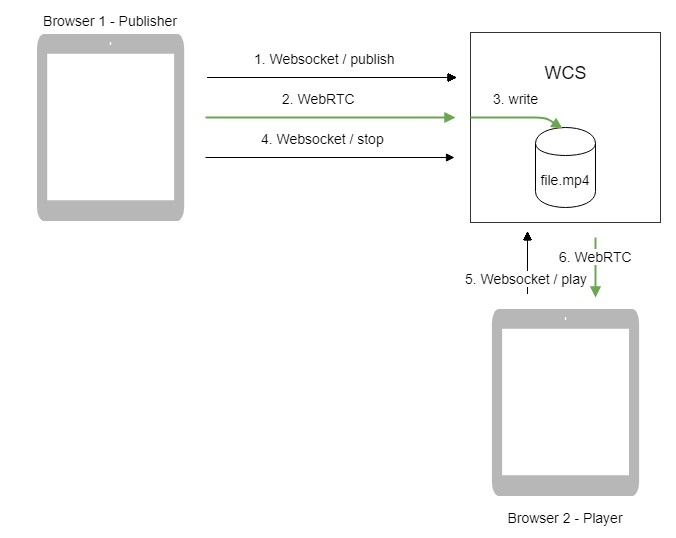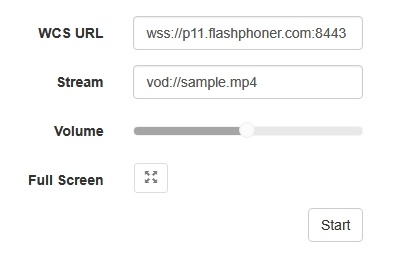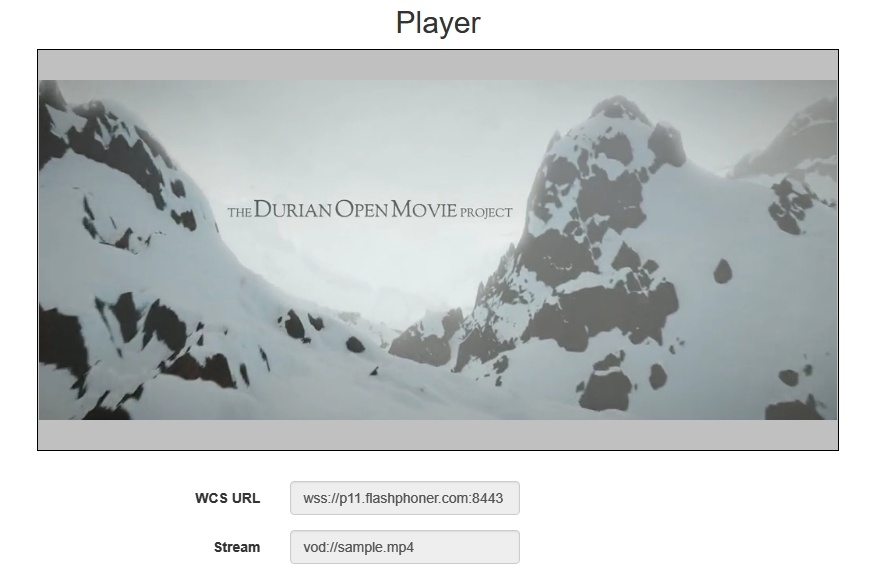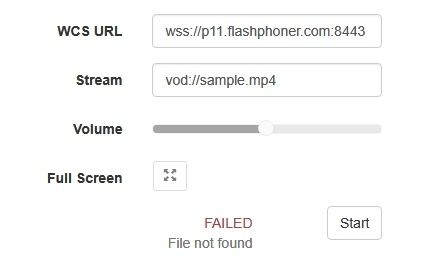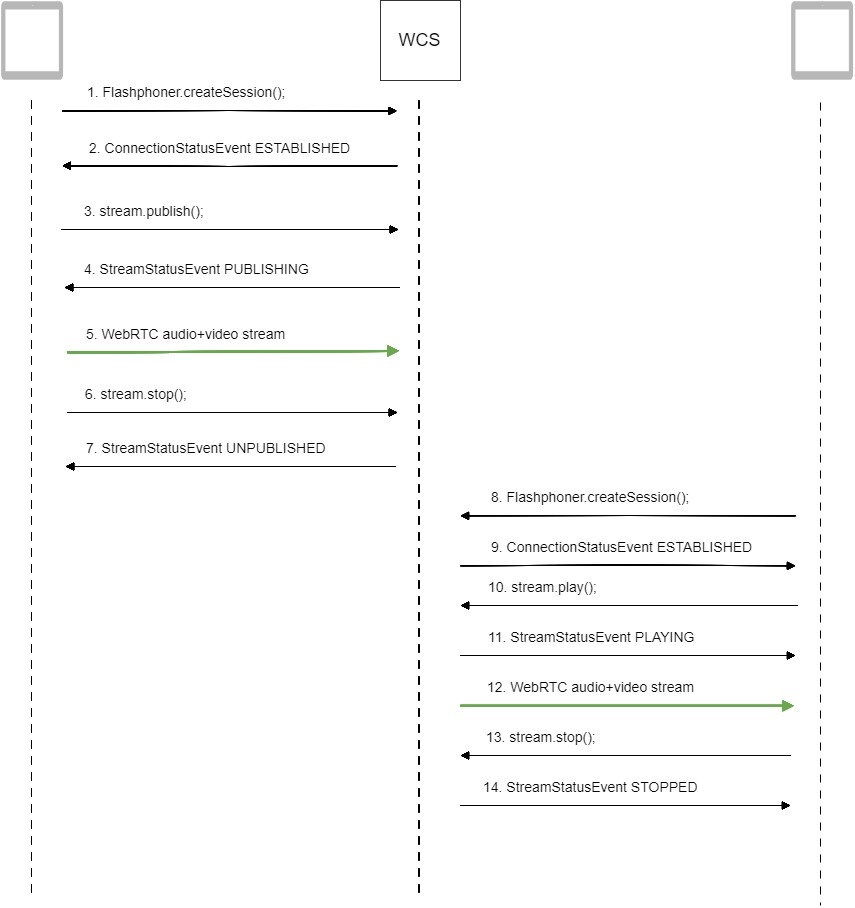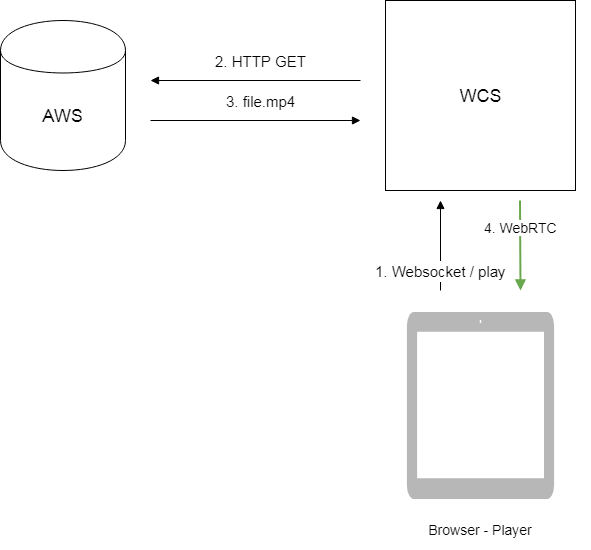WCS offers possibility to capture a media stream from an MP4 file located on the local disk of the server (Video on Demand, VOD). The received stream can be played, republished, managed just like any stream on the WCS server. First of all, this option is intended to play previously recorded broadcasts in a browsers or a mobile application on the client side.
Overview
To capture VOD from a file, specify a link to the vod file as a stream name when calling the session.createStream() function, as follows:
vod://sample.mp4
where sample.mp4 is the name of the file that should be located in /usr/local/FlashphonerWebCallServer/media folder. Since build 5.2.687, a custom folder can specified with the following parameter in flashphoner.properties file
media_dir=/usr/local/FlashphonerWebCallServer/media
If a file with such name does not exist, the server returns the StreamStatusEvent FAILED message, where the "info" field has the reason: "File not found".
A stream created this way can be displayed to one user (personal VOD). Second viewer cannot subscribe to personal VOD stream, such stream cannot be transcoded, added to mixer or played by HLS.
If a full-featured online-broadcast is required, provide the link to a file as follows:
vod-live://sample.mp4
Multiple user can connect to such a stream simultaneously. VOD live stream can be transcoded, added to mixer or played by HLS.
Supported formats and codecs
- Container: MP4
- Video: H.264
- Audio: AAC
Operation flowchart
- The browser connects to the server via WebSocket and sends the publish command.
- The browser captures the microphone and the camera and sends the WebRTC stream as H.264 + AAC to the server, enabling recording with the parameter record: true.
- The WCS server records the stream to a file.
- The browser stops publishing.
- The second browser establishes a connection via WebSocket, creates a stream, specifies the file name, and sends the play command.
- The second browser receives the WebRTC stream and plays this stream on the page.
Quick manual on testing
1. For the test we use the Player web application to play the file.
2. Upload the file to the /usr/local/FlashphonerWebCallServer/media/ directory.
3. Open the Player web application and enter the name of the file in the Stream field:
4. Click Start. The file starts playing:
5. Click Stop to stop the playback.
6. Delete the file from /usr/local/FlashphonerWebCallServer/media/
7. Click Start. You should see the FAILED status and the "File not found" message:
Call flow
Below is the call flow when using:
the Stream Recording example to publish the stream and record the file
the Player example to play the VOD stream
1. Establishing a connection to the server to publish and record the stream.
Flashphoner.createSession(); code
Flashphoner.createSession({urlServer: url}).on(SESSION_STATUS.ESTABLISHED, function(session){
...
});
2. Receiving from the server an event confirming successful connection.
ConnectionStatusEvent ESTABLISHED code
Flashphoner.createSession({urlServer: url}).on(SESSION_STATUS.ESTABLISHED, function(session){
setStatus(session.status());
//session connected, start playback
publishStream(session);
}).on(SESSION_STATUS.DISCONNECTED, function(){
...
}).on(SESSION_STATUS.FAILED, function(){
...
});
3. Publishing the stream with recording enabled.
stream.publish(); code
session.createStream({
name: streamName,
display: localVideo,
record: true,
receiveVideo: false,
receiveAudio: false
...
}).publish();
4. Receiving from the server an event confirming successful publishing of the stream.
StreamStatusEvent, status PUBLISHING code
session.createStream({
name: streamName,
display: localVideo,
record: true,
receiveVideo: false,
receiveAudio: false
}).on(STREAM_STATUS.PUBLISHING, function(stream) {
setStatus(stream.status());
onStarted(stream);
}).on(STREAM_STATUS.UNPUBLISHED, function(stream) {
...
}).on(STREAM_STATUS.FAILED, function(stream) {
...
}).publish();
5. Sending audio and video stream via WebRTC.
6. Stopping publishing the stream.
stream.stop(); code
function onStarted(stream) {
$("#publishBtn").text("Stop").off('click').click(function(){
$(this).prop('disabled', true);
stream.stop();
}).prop('disabled', false);
}
7. Receiving from the server an event confirming unpublishing of the stream.
StreamStatusEvent, status UNPUBLISHED code
session.createStream({
name: streamName,
display: localVideo,
record: true,
receiveVideo: false,
receiveAudio: false
}).on(STREAM_STATUS.PUBLISHING, function(stream) {
...
}).on(STREAM_STATUS.UNPUBLISHED, function(stream) {
setStatus(stream.status());
showDownloadLink(stream.getRecordInfo());
onStopped();
}).on(STREAM_STATUS.FAILED, function(stream) {
...
}).publish();
8. Establishing a connection to the server to play the stream.
Flashphoner.createSession(); code
Flashphoner.createSession({urlServer: url}).on(SESSION_STATUS.ESTABLISHED, function(session){
...
});
9. Receiving from the server an event confirming successful connection.
ConnectionStatusEvent ESTABLISHED code
Flashphoner.createSession({urlServer: url}).on(SESSION_STATUS.ESTABLISHED, function(session){
setStatus(session.status());
//session connected, start playback
playStream(session);
}).on(SESSION_STATUS.DISCONNECTED, function(){
...
}).on(SESSION_STATUS.FAILED, function(){
...
});
10. Playing the stream.
stream.play(); code
if (Flashphoner.getMediaProviders()[0] === "MSE" && mseCutByIFrameOnly) {
options.mediaConnectionConstraints = {
cutByIFrameOnly: mseCutByIFrameOnly
}
}
if (resolution_for_wsplayer) {
options.playWidth = resolution_for_wsplayer.playWidth;
options.playHeight = resolution_for_wsplayer.playHeight;
} else if (resolution) {
options.playWidth = resolution.split("x")[0];
options.playHeight = resolution.split("x")[1];
}
stream = session.createStream(options).on(STREAM_STATUS.PENDING, function(stream) {
...
});
stream.play();
11. Receiving from the server an event confirming successful playing of the stream.
StreamStatusEvent, status PLAYING code
stream = session.createStream(options).on(STREAM_STATUS.PENDING, function(stream) {
...
}).on(STREAM_STATUS.PLAYING, function(stream) {
$("#preloader").show();
setStatus(stream.status());
onStarted(stream);
}).on(STREAM_STATUS.STOPPED, function() {
...
}).on(STREAM_STATUS.FAILED, function(stream) {
...
}).on(STREAM_STATUS.NOT_ENOUGH_BANDWIDTH, function(stream){
...
});
stream.play();
12. Receiving of the audio-video stream via Websocket and playing it via WebRTC
13. Stopping publishing the stream.
stream.stop(); code
function onStarted(stream) {
$("#playBtn").text("Stop").off('click').click(function(){
$(this).prop('disabled', true);
stream.stop();
}).prop('disabled', false);
...
}
14. Receiving from the server an event confirming successful stopping of the playback of the stream.
StreamStatusEvent, status STOPPED code
stream = session.createStream(options).on(STREAM_STATUS.PENDING, function(stream) {
...
}).on(STREAM_STATUS.PLAYING, function(stream) {
...
}).on(STREAM_STATUS.STOPPED, function() {
setStatus(STREAM_STATUS.STOPPED);
onStopped();
}).on(STREAM_STATUS.FAILED, function(stream) {
...
}).on(STREAM_STATUS.NOT_ENOUGH_BANDWIDTH, function(stream){
...
});
stream.play();
VOD loop
VOD live translation supports VOD loop: after end of file, capturing starts from file begin. This feature is enabled with the following parameter in flashphoner.properties file
vod_live_loop=true
VOD capturing from AWS S3 or from other S3 compatible storage
VOD stream can be captured from file placed to AWS S3 storage. Comparing with VOD capture from local disk, file from external storage is downloaded and captured sequentally.
To capture VOD from AWS S3 file, specify a link to the vod file as a stream name when calling the session.createStream() function, as follows:
vod://s3/bucket/sample.mp4
where
- bucket is S3 bucket name
- sample.mp4 is file name
Since build 5.2.939 it is possible to set the full file URL in S3 storage, this allows to capture VOD from other S3 storages (Digital Ocean, Selectel etc)
Digital Ocean Spaces URL example
vod://s3/https://ams3.digitaloceanspaces.com/myspace/folder/file.mp4
Selectel URL example
vod://s3/https://s3.selcdn.ru/mystorage/file.mp4
Operation flowchart
1. Browser requests VOD capture from AWS file
2. WCS server sends request to AWS
3. File is downloaded to WCS server
4. WebRTC stream from file is sending to browser for playback
Set up
S3 credentials configuration
AWS
To download files from AWS S3 bucket, S3 credentials must be set in flashphoner.properties file
aws_s3_credentials=zone;login;hash
Where
- zone - AWS region where bucket is placed
- login - Access Key ID
- hash - Secret Accesss Key
S3 credentials setting example:
aws_s3_credentials=eu-central-1;AA22BB33CC44DE;DhlAkpZ4adclHhbLwhTNL4hvWTo80Njo
Digital Ocean Spaces
To download files from DO Spaces set the credentials as
aws_s3_credentials=ams3;access_key;secret
Where
- ams3 - digitaloceanspaces.com subdomain
- access_key - storage access key
- secret - storage access secret code
Selectel
To download files from Selectel S3 set the credentials as
aws_s3_credentials=ru-1a;login;password
Where
- ru-1a - storage region
- login - user name
- password - password
Capturing VOD stream from file while it is downloading
To capture stream from file while it is downloading, the following parameter should be set
vod_mp4_container_new=true
If channel bandwidth between WCS and S3 storage is low, or this channel is not stable enough, file bufferization may be enabled. The buffer size is set in milliseconds with the following parameter
vod_mp4_container_new_buffer_ms=10000
In this case, buffer size is 10 seconds.
File format requirements
Header section (moov) should always be before data section (mdat). File structure should be like this:
Atom ftyp @ 0 of size: 32, ends @ 32 Atom moov @ 32 of size: 357961, ends @ 357993 ... Atom free @ 357993 of size: 8, ends @ 358001 Atom mdat @ 358001 of size: 212741950, ends @ 213099951
File structure can be checked with AtomicParsley utility
AtomicParsley file.mp4 -T 1
If the file structure does not match the requiremets, this file will not be played. Wrong file structure can be fixed if necessary with ffmpeg without reencoding
ffmpeg -i bad.mp4 -acodec copy -vcodec copy -movflags +faststart good.mp4
File name requirements
Official AWS S3 documentation does not recommend to use spaces along another special characters, but does not prohibits them. If the file name contains spaces, they should be replaced by '%20', for example
vod://s3/bucket/sample%20with%20spaces.mp4
VOD capture management with REST API
REST query should be HTTP/HTTPS POST request as:
- HTTP: http://test.flashphoner.com:8081/rest-api/vod/startup
- HTTPS: https://test.flashphoner.com:8444/rest-api/vod/startup
Where:
- test.flashphoner.com - WCS server address
- 8081 - standard REST / HTTP port
- 8444 - standard HTTPS port
- rest-api - mandatory part of URL
- /vod/startup - REST method used
REST queries and responses
REST query | REST query example | REST response example | Response states | Description |
|---|---|---|---|---|
/vod/startup | {
"uri":"vod-live://sample.mp4",
"localStreamName": "test"
}
| 409 - Conflict 500 - Internal error | Capture VOD stream from file | |
| /vod/find | {
"localStreamName": "test"
}
| [
{
"localMediaSessionId": "29ec3236-1093-42bb-88d6-d4ac37af3ac0",
"localStreamName": "test",
"uri": "vod-live://sample.mp4",
"status": "PROCESSED_LOCAL",
"hasAudio": true,
"hasVideo": true,
"record": false,
"loop": false
}
]
| 200 – OK 404 – not found | Find VOD streams by criteria |
/vod/find_all | [
{
"localMediaSessionId": "29ec3236-1093-42bb-88d6-d4ac37af3ac0",
"localStreamName": "test",
"uri": "vod-live://sample.mp4",
"status": "PROCESSED_LOCAL",
"hasAudio": true,
"hasVideo": true,
"record": false,
"loop": false
}
]
| 200 – OK 404 – not found | Find all VOD streams | |
/vod/terminate | {
"uri":"vod://sample.mp4",
"localStreamName": "test"
}
| 200 - Stream is stopped 404 - Stream not found | Stop VOD stream |
Parameters
Name | Description | Example |
|---|---|---|
uri | File name to capture | vod://sample.mp4 |
| localStreamName | Stream name | test |
status | Stream status | PROCESSED_LOCAL |
| localMediaSessionId | Mediasession Id | 29ec3236-1093-42bb-88d6-d4ac37af3ac0 |
| hasAudio | Stream has audio | true |
| hasVideo | Stream has video | true |
| record | Stream is recording | false |
| loop | VOD is looped | false |
VOD looping on demand
Since build 5.2.1528 it is possible to enable VOD looping while creating VOD live translation via REST API
{
"uri":"vod-live://sample.mp4",
"localStreamName": "test",
"loop": true
}
By default, if loop parameter is not set, vod_live_loop is applied. If the parameter is set, its value is applied as follows
true- file will be loopedfalse- file will be played once, then VOD live translation will stop
The loop parameter has a precedence over vod_live_loop value.
Known limits
/rest-api/vod/startup query can be used for VOD live translations creation only. However, find, `find_all `and terminate queries can be applied both to VOD and VOD live translations.
VOD stream publishing timeout after all subscribers gone off
By default, VOD stream stays published on server during 30 seconds after last subscriber gone off, if file duration exceeds this interval. This timeout can be changed with the following parameter
vod_stream_timeout=60000
In this case, VOD stream stays published during 60 seconds.
Known issues
1. AAC frames of type 0 are not supported by ffmpeg decoder and will be ignored while stream pulled playback
Symptoms: warnings in the client log:
10:13:06,815 WARN AAC - AudioProcessor-c6c22de8-a129-43b2-bf67-1f433a814ba9 Dropping AAC frame that starts with 0, 119056e500
Solution: switch to FDK AAC decoder
use_fdk_aac=true
2. Files with B-frames can be played unsmoothly, with artifacts and freezes
Symptoms: periodic freezes and artifacts while playing VOD file, warnongs in the client log
09:32:31,238 WARN 4BitstreamNormalizer - RTMP-pool-10-thread-5 It is B-frame!
Solution: reencode this file to exclude B-frames, for example
ffmpeg -i bad.mp4 -preset ultrafast -acodec copy -vcodec h264 -g 24 -bf 0 good.mp4
3. When VOD is captured from a long-duration file, or a number of VOD streams are captured simultaneously, server process can terminate with Out of memory
Symptoms: server process terminates; "Map failed" in server log and in error*.log
19:30:53,277 ERROR DefaultMp4SampleList - Thread-34 java.io.IOException: Map failed
at sun.nio.ch.FileChannelImpl.map(FileChannelImpl.java:940)
at com.googlecode.mp4parser.FileDataSourceImpl.map(FileDataSourceImpl.java:62)
at com.googlecode.mp4parser.BasicContainer.getByteBuffer(BasicContainer.java:223)
at com.googlecode.mp4parser.authoring.samples.DefaultMp4SampleList$SampleImpl.asByteBuffer(DefaultMp4SampleList.java:204)
at com.flashphoner.media.F.A.A.A$1.A(Unknown Source)
at com.flashphoner.media.M.B.C.D(Unknown Source)
at com.flashphoner.server.C.A.B.A(Unknown Source)
at com.flashphoner.server.C.A.B.C(Unknown Source)
at java.lang.Thread.run(Thread.java:748)
Caused by: java.lang.OutOfMemoryError: Map failed
at sun.nio.ch.FileChannelImpl.map0(Native Method)
at sun.nio.ch.FileChannelImpl.map(FileChannelImpl.java:937)
... 8 more
Event: 1743.157 Thread 0x00007fc480375000 Exception <a 'java/lang/OutOfMemoryError': Map failed> (0x00000000a1d750b0) thrown at [/HUDSON/workspace/8-2-build-linux-amd64/jdk8u161/10277/hotspot/src/share/vm/prims/jni.cpp, line 735]
Solution:
1. Increase maximum number of regions of virtual memory
sysctl -w vm.max_map_count=262144
and virtual memory amount allocated to server process by changing in /usr/local/FlashphonerWebCallServer/bin/webcallserver file the string
ulimit -n 20000
to the strings
ulimit -n 20000 ulimit -v 1000000000
2. Starting from build 5.2.57, set the following parameter
vod_mp4_container_isoparser_heap_datasource=true
